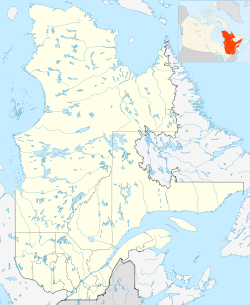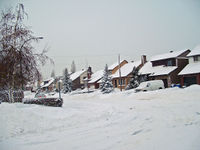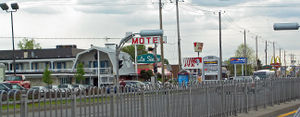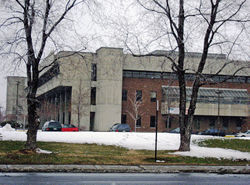Longueuil
| Longueuil | |||||
|---|---|---|---|---|---|
| — City — | |||||
| Ville de Longueuil | |||||
 |
|||||
|
|||||
| Motto: "Labor et Concordia" (Latin) "Work and Harmony" |
|||||
|
|
|||||
 Longueuil
|
|||||
| Coordinates (4250, chemin de la Savane [1]): | |||||
| Country | |||||
| Province | |||||
| Regional County | Longueuil | ||||
| Founded | 1848 | ||||
| Established | January 1, 2002 | ||||
| Electoral Districts Federal |
Saint-Lambert Saint-Bruno—Saint-Hubert Longueuil—Pierre-Boucher |
||||
| Provincial | Laporte Vachon Marie-Victorin Taillon |
||||
| Government[1][2][3] | |||||
| - Type | City | ||||
| - Mayor | Caroline St-Hilaire | ||||
| - Local government | Longueuil City Council (26 districts) |
||||
| - Federal MP(s) | Josée Beaudin (BQ) Carole Lavallée (BQ) Jean Dorion (BQ) |
||||
| - Quebec MNA(s) | Nicole Ménard (PLQ) Camil Bouchard (PQ) Bernard Drainville (PQ) Marie Malavoy (PQ) |
||||
| Area[4] | |||||
| - Total | 115.59 km2 (44.6 sq mi) | ||||
| Population (2006)[4] | |||||
| - Total | 229,330 (Ranked 19th) | ||||
| - Density | 1,984.0/km2 (5,138.5/sq mi) | ||||
| - Change (2001-06) | |||||
| - Dwellings | 101,746 | ||||
| Canada 2006 Census | |||||
| Time zone | Eastern (EST) (UTC-5) | ||||
| - Summer (DST) | EDT (UTC-4) | ||||
| Postal code(s) | J3Y, J3Z, J4G to J4N, J4T, J4V | ||||
| Area code(s) | 450 | ||||
| Access Routes[5] |
|||||
| Website | www.longueuil.ca | ||||
Longueuil (pronounced /lɒŋˈɡɔɪ/; French: [lɔ̃ɡœj]) is a city in located in the Montérégie administrative region of Quebec, and part of Greater Montreal. It sits on the south shore of the Saint Lawrence River directly across from Montreal, in southwestern Quebec. The population as of the Canada 2006 Census totaled 229,330, making it the fifth most populous city in Quebec and 19th largest in Canada. The city comprise three boroughs: Vieux-Longueuil, Saint-Hubert and Greenfield Park.
Residents of Longueuil are known as Longueuillois.
Contents |
History
Longueuil was originally part of the parish of Saint-Antoine-de-Longueuil that was created in 1845.
Longueuil was detached from the parish in 1848 and officially established as the village of Longueuil. Longueuil became a town in 1874, and then a city in 1920.
Longueuil's city limits changed for the first time in 1961 when it merged with Montréal-Sud in 1961, and again in 1969 when it merged with Ville Jacques-Cartier. In both cases, Longueuil was the surviving municipality.
On January 1, 2002, the provincial government amalgamated Longueuil with Boucherville, Brossard, Greenfield Park, LeMoyne, Saint-Bruno-de-Montarville, Saint-Hubert and Saint-Lambert.
On January 1, 2006, Boucherville, Brossard, Saint-Lambert and Saint-Bruno-de-Montarville demerged and became independent cities once again. As such, the current city of Longueuil now only includes the former cities of Longueuil, Saint-Hubert, Greenfield Park and LeMoyne.
According to Abbé Faillon, Charles Le Moyne (1626-1685), lord of the area starting in 1657, named Longueuil after a village which is today the seat of a canton in the district of Dieppe in his homeland of Normandy. In France, the name is spelled "Longueil" and it is rumored that it was a mistake to spell it "Longueuil".
Geography
Longueuil occupies 115.59 square kilometres (44.6 sq mi) of land. The city is bordered by the cities of Saint-Lambert and Brossard to the west, Boucherville to the east, Saint-Bruno-de-Montarville to the south and the Saint Lawrence River and Montreal to the north. The city of Longueuil is located approximately 7 kilometres (5 mi) south of Montreal on the south shore of the Saint Lawrence River.
Longueuil is located in the Saint Lawrence River valley, and is a vast plain. Areas near the river were originally swamp land with mixed forest, and later prime agricultural land. Agricultural land still exists in the portions of the city furthest from the river.
The city of Longueuil also includes Île Charron, a small island in the Saint Lawrence River, and part of the Boucherville Islands.
Like Montreal, Longueuil is classified as humid continental or hemiboreal (Köppen climate classification Dfb). Longueuil has long winters, lasting from November to March, short springs during April and May, average summers, lasting from June to August, and short falls during September and October.
Cityscape
Longueuil is an overwhelmingly suburban and residential city. It can be classified as a commuter town as a large portion of its residents commute to work in Montreal. Most buildings are single-family homes constructed in the post-war period. There are three boroughs in Longueuil: Vieux-Longueuil, Saint-Hubert and Greenfield Park.
Boroughs and neighbourhoods
Vieux Longueuil
Vieux-Longueuil is the borough of Longueuil that correspond to the former city of Longueuil and the former town of LeMoyne.
Former city of Longueuil
The former city of Longueuil was composed of 3 towns merged together in the 1960s: Ville Jacques-Cartier, Montréal-Sud and Longueuil (aka Old Longueuil).

LeMoyne
LeMoyne is mostly a residential neighbourhood with virtually all of its commercial activities centered on St-Louis street.
Saint-Hubert
Saint-Hubert is the second largest borough of Longueuil in terms of population and the largest in terms of area. This borough is almost entirely suburban and residential, although there are still agricultural portions in the south and east. A large industrial park exists around Montréal/Saint-Hubert Airport, and features the brand new city hall of Longueuil, the headquarters of the Canadian Space Agency and a plant of Pratt & Whitney Canada. The commercial sector of the borough centers on Cousineau Boulevard, Chambly Road and Taschereau Boulevard.
Greenfield Park
Greenfield Park is primarily a post-war area divided into two sections separated by Taschereau Boulevard.
Demographics
Population
Population trend [A][6]
| Census | Population | Change (%) |
|---|---|---|
| 2006 | 229,330 | |
| 2001 | 225,761 | |
| 1996 | 227,408 | |
| 1991 | 226,965 | N/A |
[A] These figures correspond to the territory of the city of Longueuil following the municipal reorganizations of 2002 and 2006.
According to the 2006 Canadian Census, the City of Longueuil had 229,330 people, an increase of 1.6% over 2001's figure of 225,761. Longueuil occupies 115.59 square kilometres of space, giving the city a population density of 1,984 persons per kilometre squared. There were 101,746 private dwellings, 98,735 of which were occupied by usual residents.
Of the 132,570 workers in Longueuil, the median income was $26,537, which is above Quebec's provincial average of $25,464. Among the 69,990 full time workers, the median income was $37,521 or slightly below the provincial average.[7]
| Language | Population | Percentage (%) |
|---|---|---|
| French | 181,785 | 80.15% |
| English | 15,400 | 6.79% |
| Both English and French | 1,795 | 0.79% |
| French and a non-official language | 1,245 | 0.55% |
| English and a non-official language | 350 | 0.15% |
| English, French and a non-official language | 205 | 0.09% |
| Spanish | 5,315 | 2.34% |
| Arabic | 3,155 | 1.39% |
| Creole | 1,980 | 0.87% |
| Romanian | 1,520 | 0.67% |
| Persian | 1,455 | 0.64% |
| Vietnamese | 1,395 | 0.62% |
| Portuguese | 1,365 | 0.60% |
| Chinese, n.o.s. | 1,280 | 0.56% |
| Italian | 1,245 | 0.55% |
| Ethnic Origin | Population | Percent |
|---|---|---|
| Canadian | 132,210 | 58.3% |
| French | 68,325 | 30.1% |
| Irish | 14,115 | 6.2% |
| English | 8,075 | 3.6% |
| Italian | 7,870 | 3.5% |
| First Nations | 6,780 | 3% |
| Scottish | 6,635 | 2.9% |
| Québécois | 5,630 | 2.5% |
| Haitian | 5,140 | 2.3% |
| German | 4,870 | 2.1% |
| Spanish | 3,315 | 1.5% |
| Chinese | 3,080 | 1.4% |
| Portuguese | 2,590 | 1.1% |
| Race | Population | Percentage (%) |
|---|---|---|
| White | 199,980 | 88.2% |
| Black | 9,230 | 4.1% |
| Latin American | 4,580 | 2% |
| Arab | 3,565 | 1.6% |
| Chinese | 2,710 | 1.2% |
| Southeast Asian | 2,340 | 1% |
| South Asian | 1,610 | 0.7% |

Government
Municipal
Longueuil merged on January 1, 2002 with the communities of Boucherville, Brossard, Greenfield Park, LeMoyne, Saint-Bruno-de-Montarville, Saint-Hubert, and Saint-Lambert. These cities became boroughs of the Longueuil megacity. Saint-Lambert and LeMoyne combined to become one borough called Saint-Lambert/LeMoyne. The former city of Longueuil was renamed Vieux-Longueuil borough.
The former city hall of Brossard became the city hall for the new city of Longueuil
On June 20, 2004, the former boroughs of Boucherville, Brossard, Saint-Bruno-de-Montarville and Saint-Lambert voted to demerge from Longueuil to reconstitute themselves as municipalities on January 1, 2006. The rest of the city stayed intact.
The departure of Saint-Lambert from the city Longueuil resulted in the immediate disbanding of the Saint-Lambert/LeMoyne borough. LeMoyne's small population and territory did not allowed it to become a borough of its own. In 2005, the population of LeMoyne was given the choice to pick a new borough between Vieux-Longueuil, Saint-Hubert and Greenfield Park. Vieux-Longueuil ended up being the winner and amalgamated LeMoyne into its borough on January 1, 2006.
Following the demergers, Longueuil relocated its city hall from Brossard to Saint-Hubert, where it is still located.
Since the 2002 municipal mergers, Longueuil has had three mayors. The first mayor was businessman Jacques Olivier who once served as Minister of Labour The second mayor of Longueuil was Claude Gladu, who also happened to be mayor of the former city of Longueuil from 1994 to 2002. The current mayor is Caroline St-Hilaire, a former member of the Canadian House of Commons.
The city's three remaining boroughs are Vieux-Longueuil, Greenfield Park and Saint-Hubert. In total there are 26 city councillors, including one borough mayor each.
| Borough | Population (2006) | Borough Mayor | City Councillors |
|---|---|---|---|
| Greenfield Park | 17,458 [11] | Bernard Constantini [12] | 3 |
| Saint-Hubert | 78,715 [13] | Stéphane Desjardins [14] | 8 |
| Vieux-Longueuil | 138,179 [15] | Jacques Goyette [16] | 15 |
| Mayor | Term Began | Term Ended |
|---|---|---|
| Jacques Olivier | 2002 | 2005 |
| Claude Gladu | 2006 | 2009 |
| Caroline St-Hilaire | 2009 | incumbent |
Federal and provincial
| Borough | Other cities | Federal Riding | Member of Parliament | Political Party |
|---|---|---|---|---|
| Greenfield Park, Vieux-Longueuil | Saint-Lambert | Saint-Lambert | Josée Beaudin | Bloc Québécois |
| Saint-Hubert | Saint-Bruno-de-Montarville | Saint-Bruno—Saint-Hubert | Carole Lavallée | Bloc Québécois |
| Vieux-Longueuil | Boucherville | Longueuil—Pierre-Boucher | Jean Dorion | Bloc Québécois |
| Borough | Other cities | Provincial Riding | Member of the National Assembly | Political Party |
|---|---|---|---|---|
| Greenfield Park, Saint-Hubert | Saint-Lambert | Laporte | Nicole Ménard | Quebec Liberal Party |
| Saint-Hubert | N/A | Vachon | Camil Bouchard | Parti Québécois |
| Vieux-Longueuil | N/A | Marie-Victorin | Bernard Drainville | Parti Québécois |
| Vieux-Longueuil | N/A | Taillon | Marie Malavoy | Parti Québécois |
Economy

Although a large chunk of Longueuil's work force commute to Montreal, the city nevertheless offers many jobs in a diverse range of industries. Above all, Longueuil benefits from having low property value despite its close proximity to Montreal. The city has a large retail industry, many of these jobs concentrated in malls such as Place Longueuil or commercial strips such as Taschereau Boulevard.
Longueuil is particularly strong in the aerospace industry. It is home to the headquarters of both Pratt & Whitney Canada and Héroux-Devtek, each employing thousands of workers. Also located in Longueuil is the headquarters of the Canadian Space Agency (John H. Chapman Space Center), adjacent to Montréal/Saint-Hubert Airport.
In 2008, Canadian Business ranked Longueuil as the 30th best place to do business in Canada.[17]
Culture
Media
- Le Courrier du Sud (Longueuil)
- Rive-Sud Express (Longueuil, Saint-Lambert, Boucherville, Brossard)
- Le Journal de Saint-Hubert (St. Hubert)
- Le Magazine (Greenfield Park, LeMoyne and the city of St. Lambert)
- CHMP-FM 98.5
- CHAA-FM 103.3
- Télé Rive-Sud (TVRS)
Sport
| Club | Sport | League | Stadium/Arena |
| Le Collège Français de Longueuil | Ice hockey | Quebec Junior AAA Hockey League | Colisée Jean Béliveau |
| Longueuil Ducs | Baseball | Ligue de Baseball Élite du Québec | Parc Paul-Pratt |
| Greenfield Park Packers | Canadian football | Midget AAA | Parc Pierre Laporte |
| St. Hubert Rebelles | Canadian football | Midget AAA | Centre Rosanne-Laflamme |
| South Shore Monarx | Canadian football | Quebec Junior Football League | Centre Sportif Collège Édouard-Montpetit |
Education

The city of Longueuil is served by several educational institutions. Both the Université de Montréal and Université de Sherbrooke maintain campuses in the Borough of Vieux-Longueuil, and the following CEGEPs are located in Longueuil:
- Collège Édouard-Montpetit, Borough of Vieux-Longueuil
- École nationale d'aérotechnique, Borough of Saint-Hubert
Technical and Professional Colleges
Borough of Vieux-Longueuil
- Pierre-Dupuy Professional Formation Centre
- Collège Info-Technique
Secondary schools
| School | Borough | Sector | School Board |
|---|---|---|---|
| Centennial Regional High School | Greenfield Park | Anglophone | Riverside School Board |
| Collège Charles-LeMoyne | Vieux-Longueuil | Francophone | Private school |
| Collège Français | Vieux-Longueuil | Francophone | Private school |
| Collège Notre-Dame-de-Lourdes | Vieux-Longueuil | Francophone | Private school |
| École secondaire André-Laurendeau | Saint-Hubert | Francophone | Commission scolaire Marie-Victorin |
| École secondaire Gérard-Filion | Vieux-Longueuil | Francophone | Commission scolaire Marie-Victorin |
| École secondaire Internationale St-Edmond | Greenfield Park | Francophone | Commission scolaire Marie-Victorin |
| École secondaire Jacques-Rousseau | Vieux-Longueuil | Francophone | Commission scolaire Marie-Victorin |
| École secondaire Mgr-A.M.-Parent | Saint-Hubert | Francophone | Commission scolaire Marie-Victorin |
| École secondaire Participative l'Agora | Greenfield Park | Francophone | Commission scolaire Marie-Victorin |
| École secondaire St-Jean-Baptiste | Vieux-Longueuil | Francophone | Commission scolaire Marie-Victorin |
| Heritage Regional High School | Saint-Hubert | Anglophone | Riverside School Board |
Infrastructure

Commuting patterns
According to the 2006 Census, about 39,485 city residents (17.2% of the total population) commute to work in Montreal on a daily basis, while only 38,090 residents (16.6%) work in the city itself. A further 6,915 residents (3.0%) work in Boucherville every day, 4,775 (2.1%) work in Brossard, 2,795 (1.2%) in Saint-Bruno-de-Montarville, and 1,815 (0.8%) work in Saint-Lambert, the four other constituent cities of the Longueuil agglomeration.
By contrast only 8,845 people commute from Montreal to work in Longueuil every day, while 4,080 people commute from Brossard to work in Longueuil, 2,940 people commute from Boucherville, 2,090 from Sainte-Julie, 1,825 from Saint-Bruno-de-Montarville, 1,815 from Chambly, and 1,810 from Saint-Jean-sur-Richelieu.[18]
Roads
The Saint Lawrence River between the Island of Montreal and the south shore is traversed by only five automobile crossings (the Honoré-Mercier, Champlain, Victoria, and Jacques-Cartier bridges and the Louis-Hippolyte-Lafontaine tunnel), and they are severely congested. (See the list of bridges in Montreal.)
- Quebec Autoroutes:
- Autoroute 20
- Autoroute 30
- Quebec Provincial Highways:
- Route 112
- Route 116
- Route 132
- Route 134
- Boulevards
- Taschereau Boulevard
- Cousineau Boulevard
- Grande Allée Boulevard
- Curé Poirier Boulevard
- Churchill Boulevard
- Jacques Cartier Boulevard
- Roland Therrien Boulevard
Public Transportation
The Réseau de transport de Longueuil (RTL) provides bus service in Longueuil. There are 71 bus routes and 13 shared taxi routes serving 117,804 passengers per day, and 30,970,996 passengers annually.[19] Almost all bus lines of the RTL terminate at the Longueuil Bus Terminus. Many buses terminating at the other main bus terminus, Brossard-Panama, cross the Champlain Bridge to arrive at the Terminus Centre-Ville (AMT) in downtown Montreal (under the 1000 de la Gauchetière office tower, at Bonaventure metro).
The city is also served by the Longueuil–Université-de-Sherbrooke metro station, adjacent to the Longueuil bus terminus. The station connects to downtown Montreal via the yellow line of the metro. The Agence métropolitaine de transport (AMT) runs the Mont-Saint-Hilaire commuter train line also serves the south shore. The only commuter train station in the city of Longueuil is Saint-Hubert Station. Until the mid-1950s, Longueuil was served by interurban streetcars operated by the Montreal and Southern Counties Railway.
Longueuil also has a small airport, Saint-Hubert Airport. It is one of Canada's most important general aviation airports, ranked 12th busiest airport by aircraft movements.[20]
Hospitals
The city is served by two hospitals. The Charles-LeMoyne Hospital in the borough of Greenfield Park is the main hospital for Greenfield Park and Saint-Hubert. The Pierre-Boucher Hospital is the main hospital for the borough of Vieux-Longueuil.
Partner cities
 Whitby, Ontario
Whitby, Ontario Lafayette, Louisiana, United States [21]
Lafayette, Louisiana, United States [21]
See also
- List of municipalities in Quebec
References
- ↑ 1.0 1.1 Ministère des Affaires Municipales et Régions: Longueuil
- ↑ Parliament of Canada Federal Riding History: SAINT-LAMBERT (Quebec)
Parliament of Canada Federal Riding History: SAINT-BRUNO--SAINT-HUBERT (Quebec)
Parliament of Canada Federal Riding History: LONGUEUIL--PIERRE-BOUCHER (Quebec) - ↑ Chief Electoral Officer of Québec - 40th General Election Riding Results: LAPORTE
Chief Electoral Officer of Québec - 40th General Election Riding Results: VACHON
Chief Electoral Officer of Québec - 40th General Election Riding Results: MARIE-VICTORIN
Chief Electoral Officer of Québec - 40th General Election Riding Results: TAILLON - ↑ 4.0 4.1 2006 Statistics Canada Community Profile: Longueuil, Quebec
- ↑ Official Transport Quebec Road Map
- ↑ Statistics Canada: 1996, 2001, 2006 census
- ↑ "Income and earnings for Longueuil". Canada 2006 Census. Statitstics Canada. April 30, 2008. http://www12.statcan.ca/english/census06/data/profiles/community/Details/Page.cfm?Lang=E&Geo1=CSD&Code1=2458227&Geo2=PR&Code2=24&Data=Count&SearchText=Longueuil&SearchType=Begins&SearchPR=01&B1=Income%20and%20earnings&Custom=. Retrieved 2008-05-17.
- ↑ "Longueuil, V.". Detailed Mother Tongue (103), Knowledge of Official Languages (5), Age Groups (17A) and Sex (3) for the Population of Canada, Provinces, Territories, Census Divisions and Census Subdivisions, 2006 Census - 20% Sample Data. Statistics Canada. 2007-11-20. http://www12.statcan.ca/english/census06/data/topics/RetrieveProductTable.cfm?ALEVEL=3&APATH=3&CATNO=&DETAIL=0&DIM=&DS=99&FL=0&FREE=0&GAL=0&GC=99&GK=NA&GRP=1&IPS=&METH=0&ORDER=1&PID=89202&PTYPE=88971&RL=0&S=1&ShowAll=No&StartRow=1&SUB=701&Temporal=2006&Theme=70&VID=0&VNAMEE=&VNAMEF=&GID=772944. Retrieved 2008-02-06.
- ↑ Ethnocultural Portrait of Canada Highlight Tables: Longueuil
- ↑ 2006 Community Profiles - Longueuil
- ↑ Ville de Longueuil - Greenfield Park - Portrait
- ↑ Ville de Longueuil - Greenfield Park - Vie municipale
- ↑ Ville de Longueuil - Portrait
- ↑ Ville de Longueuil - Saint-Hubert - Vie municipale
- ↑ Ville de Longueuil - Vieux-Longueuil - Portrait
- ↑ Ville de Longueuil - Vieux-Longueuil - Vie municipale
- ↑ "The Best Places to do Business in Canada". Canadian Business. 2008. http://list.canadianbusiness.com/rankings/best-places-to-do-business/2008/Default.aspx?sp2=1&d1=a&sc1=7. Retrieved 2008-11-12.
- ↑ "Longueuil, V (Que.)". Commuting Flow Census Subdivisions: Sex (3) for the Employed Labour Force 15 Years and Over Having a Usual Place of Work of Census Subdivisions, Flows Greater than or Equal to 20, 2006 Census - 20% Sample Data. Statistics Canada. 2008-04-02. http://www12.statcan.ca/english/census06/data/topics/RetrieveProductTable.cfm?ALEVEL=3&APATH=3&CATNO=97-561-XCB2006011&DETAIL=0&DIM=&DS=99&FL=0&FREE=0&GAL=&GC=99&GK=NA&GRP=0&IPS=97-561-XCB2006011&METH=0&ORDER=&PID=90656&PTYPE=88971&RL=0&ShowAll=&StartRow=&SUB=&Temporal=2006&Theme=76&VID=&VNAMEE=&VNAMEF=&S=1&O=D&A=W&PRID=0&GID=2458227. Retrieved 2008-04-02.
- ↑ "Portrait de la clientèle" (in French) (PDF). Statistics. Réseau de transport de Longueuil. December 31, 2008. http://www.rtl-longueuil.qc.ca/images/statistique.pdf. Retrieved 2008-12-22.
- ↑ - Aircraft Movement Statistics: NAV CANADA Towers and Flight Service Stations: Annual Report 2007
- ↑ "Lafayette's Sister Cities". City of Lafayette. http://www.lecentre.org/discover_lecentre_english_sister.asp. Retrieved 2009-10-16.
External links
 |
Boucherville |  |
||
| Saint Lawrence River / Montreal | Saint-Bruno-de-Montarville | |||
| Saint-Lambert | Brossard | Carignan |
|
||||||||||||||||||||||||||||||||
|
||||||||||||||
|
|||||||||||
|
||||||||||||||
.svg.png)
.svg.png)
